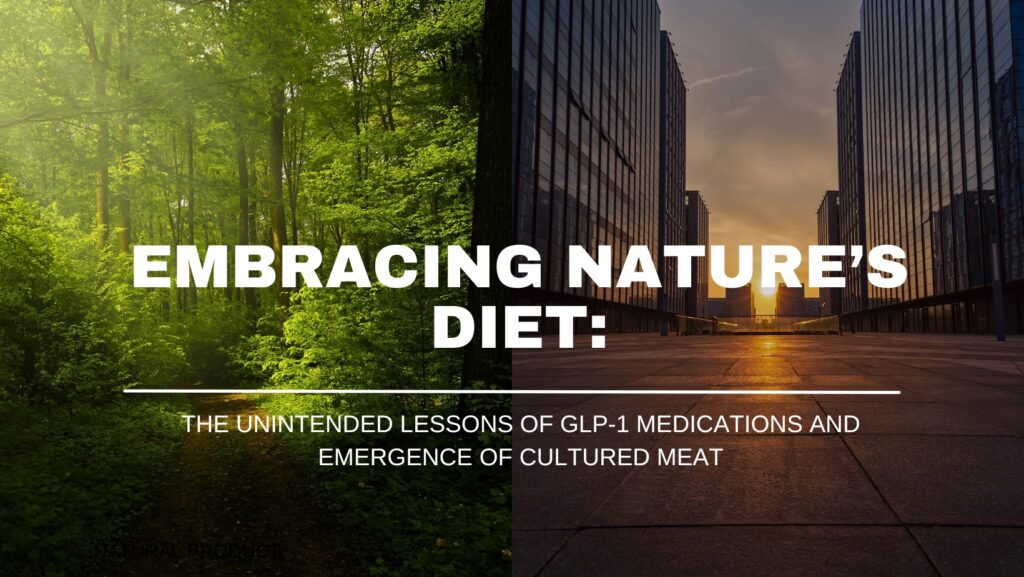Introduction: In the quest for sustainable and healthy living, two recent developments stand out: the emergence of cultured meat and the surge in the use of GLP-1 medications for weight loss. While these advancements stem from different industries and serve different purposes, they intersect intriguingly in their environmental implications. My observation is that while cultured meat is an innovative approach, it may not be the most effective solution for reducing the environmental impact of meat consumption. Instead, the increasing use of GLP-1 medications, originally developed for diabetes control, may inadvertently nudging people towards a more whole plant-based diet – a natural and holistic approach to health and environmental sustainability.
Cultured Meat: A Technological Leap with Limitations: Cultured meat, grown in labs from animal cells, presents a futuristic solution to the environmental woes of traditional livestock farming. Despite its potential to reduce greenhouse gas emissions, this technology faces significant challenges at its initial stage. High production costs, energy-intensive processes, and the complexity of scaling up highlight that lab-grown meat may not be the all-encompassing answer we seek.
The Uptake of GLP-1 Medications and Food Consumption: The hot drug in the news, known as GLP-1 receptor agonists, initially developed for diabetes management and later adapted for weight loss, is having an unforeseen impact on consumer eating habits. The drugs semaglutide (sold as Wegovy) and tirzepatide (sold as Mounjaro) imitate the action of glucagon-like peptide-1 (GLP-1). This increases the production of insulin (which transports blood sugar into body cells) and reduces the production of glucagon (which releases sugar into the bloodstream from the liver). It also slows down the rate at which the stomach empties, creating a feeling of fullness that reduces appetite. In addition, the drug may increase energy expenditure by changing fat tissue into brown adipose tissue, which is more likely to be burned at rest. These effects not only help diabetics, but also promote weight loss. These medications, by aiding weight management, are inadvertently leading to a decrease in overall food consumption. Much of what we consume today looks nothing like what our ancestors put on their plates, skewed as it is towards processed food. The correlation between highly processed foods and raising health issues has been well demonstrated. The grocery industry has already noticed the impact of uptake of GLP-1 medications. A report by Timothy Inklebarger published in Supermarket News on December 6, 2023 revealed that key departments, such as bakery and deli, see declines of up to 20% from those on GLP-1 drugs.
The Unforeseen Environmental Impact of GLP-1 Medications : One pleasant “side-effect” of GLP-1 medication is the hunger suppression leads to the reduction of the purchase of high-calorie, environmentally taxing food items. On the other hand, it is found that consumption of whole plant-based foods rich in prebiotic fibers can relief some of the side effects of GLP-1 drugs – like vomiting, diarrhea, constipation, and bloating. Consumption of prebiotic rich foods also reduce food cravings and boost metabolisms. This shift, though not initially intended for environmental benefits, aligns perfectly with the goal of reducing the environmental footprint of our diets.
Advocating for Whole Plant-Based Diets: The natural solution to both our health and environmental concerns lies in whole, plant-based diets. Emphasizing vegetables, grains, and fruits, this dietary approach is inherently low in environmental impact. Plant-based diets require fewer resources like water and land, and they offer the added benefit of being minimally processed. This shift towards nature’s bounty not only enhances personal health but also plays a critical role in conserving our planet.
Drawing Connections for a Sustainable Future: While cultured meat and GLP-1 medications originated from different needs – one from environmental concerns and the other from health care – their paths converge in influencing our dietary choices. The pleasant environmental impact of GLP-1 medication usage highlights a broader lesson: health-focused innovations can have positive environmental side effects. This revelation reinforces the idea that a diet rich in whole plants is not just a choice for personal health but a step towards environmental stewardship.
Conclusion: In navigating the complexities of sustainable living, it becomes clear that nature often offers the best solutions. While cultured meat represents a notable scientific endeavor, it may fall short of being the ultimate solution to our environmental challenges. Instead, the incidental push towards plant-based diets by GLP-1 medications serves as a reminder of the power of natural, simple dietary choices in protecting both our health and our planet. As we embrace these insights, we move closer to a future where our food choices are in harmony with the natural world.
References:
Statista – Various Articles
Economist – Various Articles
Pitchbook – Various Articles
Supermarket News – Grocers take a hit from new weight-loss meds











